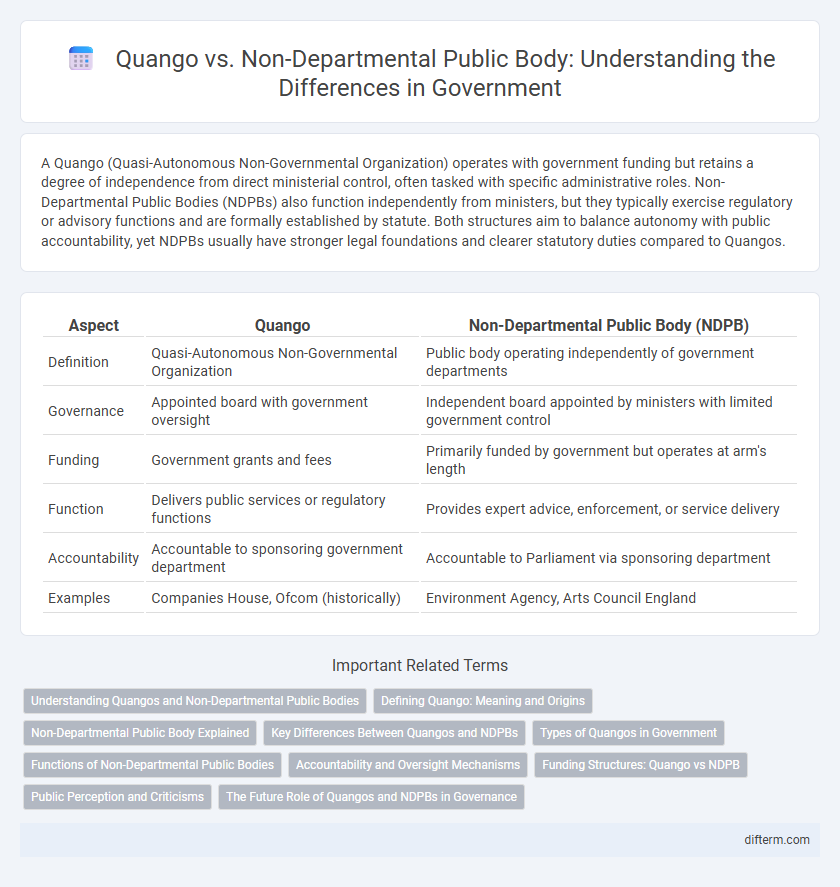A Quango (Quasi-Autonomous Non-Governmental Organization) operates with government funding but retains a degree of independence from direct ministerial control, often tasked with specific administrative roles. Non-Departmental Public Bodies (NDPBs) also function independently from ministers, but they typically exercise regulatory or advisory functions and are formally established by statute. Both structures aim to balance autonomy with public accountability, yet NDPBs usually have stronger legal foundations and clearer statutory duties compared to Quangos.
Table of Comparison
| Aspect | Quango | Non-Departmental Public Body (NDPB) |
|---|---|---|
| Definition | Quasi-Autonomous Non-Governmental Organization | Public body operating independently of government departments |
| Governance | Appointed board with government oversight | Independent board appointed by ministers with limited government control |
| Funding | Government grants and fees | Primarily funded by government but operates at arm's length |
| Function | Delivers public services or regulatory functions | Provides expert advice, enforcement, or service delivery |
| Accountability | Accountable to sponsoring government department | Accountable to Parliament via sponsoring department |
| Examples | Companies House, Ofcom (historically) | Environment Agency, Arts Council England |
Understanding Quangos and Non-Departmental Public Bodies
Quangos, or Quasi-Autonomous Non-Governmental Organizations, operate independently from direct government control while receiving public funding to perform specific administrative functions. Non-Departmental Public Bodies (NDPBs) are a subtype of quangos characterized by their non-ministerial status, providing expert advice or delivering public services outside ministerial departments. Understanding the distinctions between quangos and NDPBs is essential for grasping their roles in public administration, accountability frameworks, and government oversight mechanisms.
Defining Quango: Meaning and Origins
A Quango, or Quasi-Autonomous Non-Governmental Organization, is a public agency funded by the government but operates independently from direct ministerial control, primarily established to deliver specific public services or functions. Originating in the United Kingdom during the 1960s, Quangos were designed to provide a degree of operational flexibility and reduce political interference while maintaining accountability through government funding. These bodies play a vital role in decentralizing government functions, often bridging the gap between central government and the public sector.
Non-Departmental Public Body Explained
A Non-Departmental Public Body (NDPB) operates independently from ministerial departments but remains funded and overseen by the government to deliver specific public functions. NDPBs are established to provide impartial advice, execute administrative tasks, or regulate sectors without direct political control, ensuring accountability through appointed boards and annual reporting. Their operational autonomy distinguishes them from core government departments, enabling efficiency and specialized governance within the public sector.
Key Differences Between Quangos and NDPBs
Quangos (Quasi-Autonomous Non-Governmental Organizations) operate with significant independence from direct government control but typically receive public funding to deliver specific services or functions, whereas Non-Departmental Public Bodies (NDPBs) are formally established by the government to perform administrative, advisory, or executive roles on its behalf. Quangos often have board members appointed from outside government departments, maintaining autonomy in decision-making, while NDPBs function under statutory frameworks with clearer accountability to government ministers. The primary distinction lies in their establishment and oversight mechanisms: Quangos exist more informally with less direct ministerial control, whereas NDPBs are legally constituted entities with defined public responsibilities and governance structures.
Types of Quangos in Government
Quangos, or Quasi-Autonomous Non-Governmental Organizations, include advisory bodies, executive agencies, and tribunals that operate at arm's length from central government, ensuring specialized governance and public service delivery. These entities vary from Non-Departmental Public Bodies (NDPBs), which are funded by government departments but maintain operational independence, to regulatory authorities that oversee compliance within specific sectors. Understanding the types of quangos helps clarify their roles in policy implementation, regulatory functions, and public administration across different government areas.
Functions of Non-Departmental Public Bodies
Non-Departmental Public Bodies (NDPBs) perform specific public functions delegated by the government while operating at arm's length from ministers, ensuring impartiality and operational independence. These bodies undertake regulatory, advisory, and service delivery roles, such as managing public resources, setting standards, or administering grants, which differ from Quangos primarily in governance structure and oversight. NDPBs maintain accountability through formal frameworks like parliamentary scrutiny and reporting requirements, balancing autonomy with public interest obligations.
Accountability and Oversight Mechanisms
Quangos (Quasi-Autonomous Non-Governmental Organizations) and Non-Departmental Public Bodies (NDPBs) operate with varying degrees of government oversight, with NDPBs typically subject to stricter accountability frameworks mandated by specific legislation. Quangos often have more operational independence but remain accountable through ministerial directives and parliamentary scrutiny to ensure alignment with government policy. Both entities undergo financial audits and performance evaluations, yet NDPBs are generally required to publish detailed reports and undergo more rigorous public and parliamentary oversight mechanisms.
Funding Structures: Quango vs NDPB
Quangos (Quasi-Autonomous Non-Governmental Organizations) receive funding primarily through government grants while maintaining operational independence, allowing flexibility in budget management. Non-Departmental Public Bodies (NDPBs) are mainly financed via departmental allocations with more direct oversight and spending restrictions imposed by sponsoring government departments. The funding structure differences impact accountability, with Quangos having greater autonomy in financial decisions compared to the more regulated financial governance seen in NDPBs.
Public Perception and Criticisms
Quangos (Quasi-Autonomous Non-Governmental Organizations) often face public criticism due to perceptions of inefficiency, lack of transparency, and excessive bureaucracy compared to Non-Departmental Public Bodies (NDPBs). NDPBs tend to be viewed more favorably as they typically have clearer accountability structures and stronger regulatory oversight, which can improve public trust. Public perception issues surrounding quangos include concerns over political independence and misallocation of funds, fueling debates about reform and governance standards.
The Future Role of Quangos and NDPBs in Governance
Quangos and Non-Departmental Public Bodies (NDPBs) are pivotal in delivering public services and shaping policy implementation while maintaining a degree of operational independence from central government. The future role of Quangos and NDPBs in governance is increasingly centered on enhancing accountability, improving efficiency, and fostering closer collaboration with government departments to address complex societal challenges. Innovations in digital governance and data-driven decision-making are expected to redefine their functions, emphasizing transparency, stakeholder engagement, and adaptive service delivery models.
Quango vs Non-Departmental Public Body Infographic

 difterm.com
difterm.com